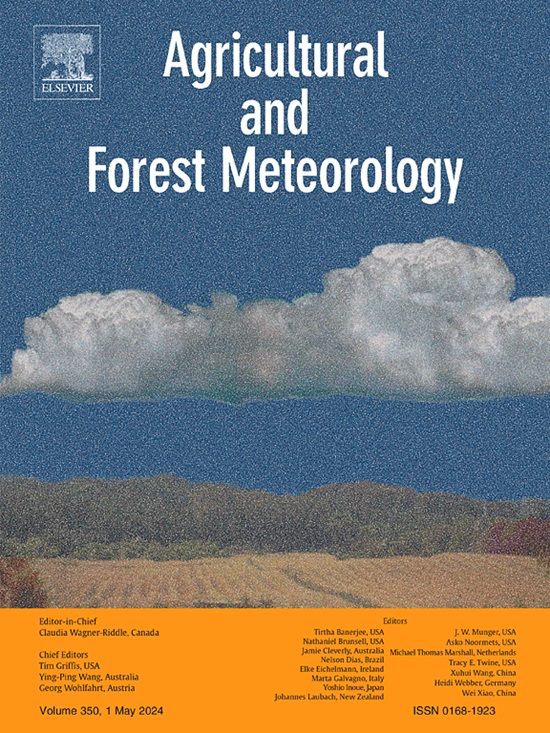亚马逊森林砍伐通过当地主导的生物物理机制加剧了大气干旱
IF 5.7
1区 农林科学
Q1 AGRONOMY
引用次数: 0
摘要
近几十年来,亚马逊盆地经历了严重的森林砍伐;然而,这种森林砍伐对蒸汽压赤字(VPD)的影响尚不清楚。VPD是表征大气干燥度的关键变量。本文利用耦合地球系统模型分析了理想森林砍伐实验,探讨了森林砍伐与VPD增加之间的双向关系。在模拟中,亚马逊森林砍伐导致VPD大幅增加,并启动了一个正反馈机制。研究发现,森林砍伐引起的亚马逊流域VPD增加中,大气水汽需求增加贡献了40%,而大气水汽供应减少贡献了60%。具体而言,由于短波透过率和空气动力阻力的变化,局地辐射强迫的增加导致局地变暖,局地变暖在大气蒸汽需求的增加中起主导作用。与此同时,森林砍伐导致的蒸散发减少主导了大气蒸汽供应的减少。我们的研究结果表明,亚马逊地区森林砍伐与VPD增加之间可能存在正反馈机制,并表明亚马逊地区大规模森林砍伐可能引发大气干旱的不可控增加。本文章由计算机程序翻译,如有差异,请以英文原文为准。
Amazon deforestation intensifies atmospheric aridity through locally dominant biophysical mechanisms
The Amazon basin has experienced severe deforestation in recent decades; however, the impact of this deforestation on vapor pressure deficit (VPD) remains unclear. VPD is a key variable used to characterize atmospheric aridity. Here, we analyze idealized deforestation experiments with coupled Earth system models, exploring the bidirectional relationship between deforestation and increased VPD. In simulations, Amazon deforestation causes a substantial increase in VPD, and initiated a positive feedback mechanism. We find that 40 % of the deforestation-induced increase in VPD in the Amazon basin is contributed by increasing atmospheric vapor demand, while 60 % is contributed by decreasing atmospheric vapor supply. Specifically, increased local radiative forcing due to changes in shortwave transmissivity and aerodynamic resistance results in local warming, which plays a dominant role in the increase in atmospheric vapor demand. Meanwhile, reduced evapotranspiration caused by deforestation dominates the decrease in atmospheric vapor supply. Our results show a possible existence of a positive feedback mechanism between deforestation and VPD increase in the Amazon, and suggest that large-scale Amazon deforestation may trigger uncontrollable increases in atmospheric aridity.
求助全文
通过发布文献求助,成功后即可免费获取论文全文。
去求助
来源期刊
CiteScore
10.30
自引率
9.70%
发文量
415
审稿时长
69 days
期刊介绍:
Agricultural and Forest Meteorology is an international journal for the publication of original articles and reviews on the inter-relationship between meteorology, agriculture, forestry, and natural ecosystems. Emphasis is on basic and applied scientific research relevant to practical problems in the field of plant and soil sciences, ecology and biogeochemistry as affected by weather as well as climate variability and change. Theoretical models should be tested against experimental data. Articles must appeal to an international audience. Special issues devoted to single topics are also published.
Typical topics include canopy micrometeorology (e.g. canopy radiation transfer, turbulence near the ground, evapotranspiration, energy balance, fluxes of trace gases), micrometeorological instrumentation (e.g., sensors for trace gases, flux measurement instruments, radiation measurement techniques), aerobiology (e.g. the dispersion of pollen, spores, insects and pesticides), biometeorology (e.g. the effect of weather and climate on plant distribution, crop yield, water-use efficiency, and plant phenology), forest-fire/weather interactions, and feedbacks from vegetation to weather and the climate system.

 求助内容:
求助内容: 应助结果提醒方式:
应助结果提醒方式:


